Fond du Lac River






The Fond du Lac River has its headwaters near Ripon, Wisconsin where it flows east into the Eldorado Marsh. Following the marsh, the river quickly drops in elevation before turning sharply north to flow through downtown Fond du Lac and then subsequently empties into Lake Winnebego. This isn’t a well known paddling river, but locals know and like it.
I scouted it this spring and while I liked the Eldorado marsh area, access and cattails seemed problematic. The final downtown section in contrast had a beat-up industrial feel to it and didn’t look nice. The middle section though was baby bear perfect. After patiently waiting 6 months for the waters to come down (it’s been a very wet spring), I finally got the chance to paddle this at ideal conditions.
The trip starts at Hwy 23 which (long story short) is probably your best put-in option (short story long later). The first half mile up to Forest Ave is a continuation of the Eldorado Marsh. The channel consists of a narrow and scenic cattail corridor with swift current. Abundant pondweeds flow gracefully in the river, which you could easily see through the three foot depth.
After Forest Ave the river really changes. The cattails give way to nicely wooded banks, the channel becomes shallower and rocky, and I started to see frequent riffles and even small boulder gardens. What’s remarkable about this river is that is doesn’t have a lot of mud, and instead the substrate is filled with small red rocks. Occasionally I paddled over flat slabs of bedrock (likely Niagara dolomite) and at one point this extended up over the banks and formed a small rock outcrop.
From Forest Ave to Hwy T, the river is quite narrow and heavily wooded, which, with the riffly current and rocks was quite striking. Unfortunately, it was quite sunny that day and many of my pictures didn’t turn out. As a rough rule of thumb for paddling photography, you want to do big open rivers on sunny days and shady creeks on overcast days once the leaves are out. Live and learn.
A nice perk of the trip was despite being in the Fond du Lac metro area, there were very few homes (maybe 2) and road noise was largely not an issue. Although paddlers will see occasional planes fly overhead as the local county airport is nearby. My little yellow kayak on the blue river likely stood out like a sore thumb to most passing pilots.
After Esterbrook Road and south of the airport, the river really opens up into a grassland paddle, which was a nice contrast to the earlier woods. The current though stays fast and some of the best rapids are in this section (but they still are pretty minor).
I took out at Rogersville Road (eastern end), but suspect many paddlers will want to lengthen the trip. Likely the river stays nice up to about South Hickory Street. But after that, you will see a lot of beat up industrial development and large concrete retaining walls, which to me isn’t as interesting. The East Branch then joins in, but is much muddier and inferior to the west branch and the river really goes downhill from there. Finally you can (and most paddlers do) take out at one of the parks on Lake Winnebago.
I gave this trip five stars as it is the type of paddle I personally prefer (small creek, rocky, fast, clear water, thick woods, no logjams…), but in all fairness I expect most paddlers would consider this a four-star trip instead. This is a volatile river and poor timing could easily knock a star off this river (more on this below).
Decent bridge access at Hwy 23. Bit weedy, but plenty doable and easy to launch directly under the bridge. I saw three other cars parked here so suspect it is the most popular launch option. Only downside is that Hwy 23 is insanely busy and fast. Plenty of shoulder parking but little privacy.
Rogersville Road crosses the river twice and both bridge are take-out options. The road is somewhat unique in that it has been recently split by a local runway extension thus creating two dead-end segments leading to the airport. The county frequently gates off both bridges, but you should be ok as you don’t need to cross the bridge to take out. Of the two bridges, the eastern one is the better option IMO. It’s secluded and there is a pull-off that you can park in. Only downside is it is a bit weedy and mucky, and you will have to drag your boat up the embankment (but quite doable).
I assume most paddlers will simply paddle the additional 4.6 miles to reach Lake Winnebago where there are numerous parks and great take-out options.
The bike shuttle is only 4.5 miles and has no major hills (although a few long shallow ones). Unfortunately about 3 miles of the shuttle are on Hwy 23 which is a very fast busy road with narrow shoulders.
Note, if you want to paddle the additional 4.6 miles to reach Lake Winnebago (11.6 total river miles), the good news is your bike shuttle will be only 5.1 miles. Hwy 23 can then be almost completely bypassed by taking Hwy OOO (or by using the nearby Mascoutin Valley State Trail if you are into mountain biking).
A surprisingly safe river and I never once had to portage (thanks to the tremendous cleanup work done by locals). There were two instances in which I had to “hop” over downed trees, and two instances where I had to duck under narrow chutes in fast water, but I didn’t think these were too bad although could be at different water levels. Regardless if you do portage it wouldn’t be difficult as this river doesn’t have a lot of mud or big banks
The current was quite zippy and fun. Maybe 4-5 Class 1 rapids, the rest light riffles. No Class 2 rapids.
This river is often too high or too low, so timing is important. I did this at 41 CFS per the nearby Rock River – South Branch Gauge. This is probably the most representative gauge (same size rivers, very nearby, both transition from marshy areas to rocky, fast channels), but it might still be inaccurate. At my depth, much of the upper river averaged 2-3 feet deep and the lower sections maybe averaged 1 foot. The riffles are where the shallow parts are. I got hung up twice on the 7 miles and hit a few rocks here and there, but for the most part was able to go over the light rapids no problem. At this depth, water clarity was ok but could have been much better.
- 0-20 CFS: Likely too shallow. 10 CFS is a common summertime average.
- 21 to 35 CFS: Most of the river will be navigable but you might have to walk say 6-8 of the riffles. Might be worth it as clarity should be excellent. Scouted at 27 CFS.
- 36 – 50 CFS: A very ideal range. Trip was done at 41 CFS, which was great. I would be willing to go shallower but suspect this might be the floor for most kayakers.
- 51-75 CFS: River probably loses a lot of clarity and boulder gardens at this point. Still plenty navigable, just not as scenic.
- 76-100 CFS: The river will be high and dirty. I actually think this is a popular paddling depth with locals worried about low water, but I don’t think it would be as enjoyable.
- 101+ CFS: At this point the river might start to become too obnoxious.
No really unique wildlife sightings, but the river felt plenty alive with many small fish in the water, dragonflies in the air, and a nice soundtrack sung by the frogs and the birds. Lot of huge carp in the upper portions of the river (but really all carp seem huge). The highlight was seeing through the clear water so many pebble pyramids built by fish to protect their eggs (some were over two feet wide).
Main Branch/West Branch:
- Hwy 26 to Fremont Road: 1.8 miles. Small creek that grows quickly. Heavily channelized.
- Fremont Road to Hwy C: 3.3 miles. Attractive creek with a number of riffles. Maybe 3-4 logjams.
- Hwy C to Eldorado Dam/Dike Road: 3.7 miles. Inviting creek and good public access by former dam. Runs for a mile through a riffly wooded section before emptying into the Eldorado Marsh (an artificial cattail flowage). Mostly open, but maybe 1-2 logjams. The problem is the flowage constricts the channel and the center portion may not be passable (see satellite images). Supposedly paddlers do paddle the marsh though and one source called it an “unknown canoeist paradise“.
- Eldorado Dam to Hwy 23: 3.1 miles. Nice section through the marsh. Unlike the section upstream of the dam, this downstream section is quite navigable. The put-in at the dam is not located near a public parking lot and you will have to drag your boat a third of a mile to reach the water.
- Hwy 23 to Rogersville Road (East Spur): 7.1 miles.
- Hwy 23 to Forest Ave: 0.6 miles. Nice stretch and the last remnants of the marsh.
- Forest Ave to Townline Road: 1.9 miles. Forest Ave seems like a doable bridge access. Neat riffly section.
- Townline Road to Esterbrook Road: 2.0 miles. Townline is probably doable for access, but the best access might be over private land. This segment is great…more nice riffles and small boulder gardens.
- Esterbrook Road to Rogersville Road (West Spur): 0.8 miles. Esterbrook is probably not a good access option as it is too close to homes. River starts to open up, but is still very scenic.
- Rogersville Road (West Spur) to Rogersville Road (East Spur): 0.9 miles. The west dead-end is likely an access option. This segment is very open and has the best rapids. Runs past the county airport.
- Rogersville Road (East Spur) to Fido Dog Park/Satterlee Street: 3.2 miles. First half is likely nice…narrow and wooded. Second half is likely less interesting…slower, wider, muddier and more industrial.
- Fido Dog Park to Mouth: 1.4 miles. After the east branch joins, the river becomes wide, slow, muddy and less interesting. The backwaters (Adelaide Park and Supple Marsh) might be fun to explore. Many take-out options on Lake Winnebago. Dog Park (not to be confused with Fido Dog Park) is perhaps the best.
East Branch:
The East Branch is also navigable but inferior to the West Branch as it is more industrial, has more logjams, and much, much more mud. The rapids are also likely stronger.
- Hwy D to River Road: 1.7 miles. The bar by Hwy D has the best access, but you’ll likely need to ask permission to launch here. Some thick woods mean likely a handful of jams. Some rapids.
- River Road to Hickory Road: 3.4 miles. Not sure if River Road is an ok access option. This segment likely has many logjams.
- Hickory Road to South Street: 7.1 miles. Probably ok to launch south of the Hickory Road bridge. Probably the most interesting section and perhaps some strong rapids. Just not sure about logjams.
- South Street to FIDO Dog Park: 1.6 miles. South Street should have good public access and parking by the trailhead. This section flows through the heart of downtown Fond du Lac and is very industrial and beat-up. Lot of concrete walls and riprap. Quite navigable though. Fido Dog Park marks the confluence with the main branch.
De Neveu Creek:
- Brookfield Park to Lakeside Park Marina: 2.8 miles. Very scenic, super narrow creek with a lot of potential. Requires high water and will have some rapids. Likely some logjams.





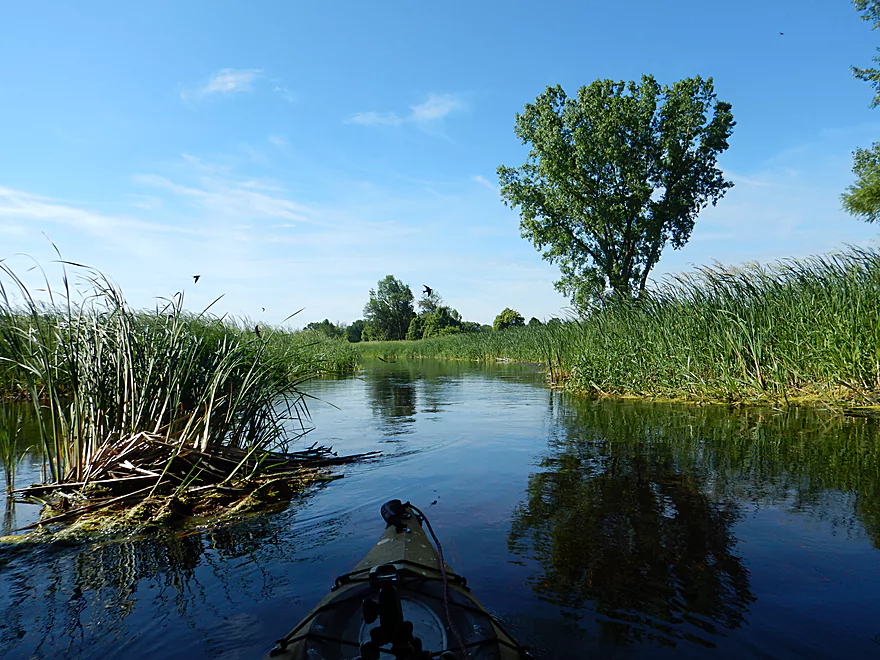



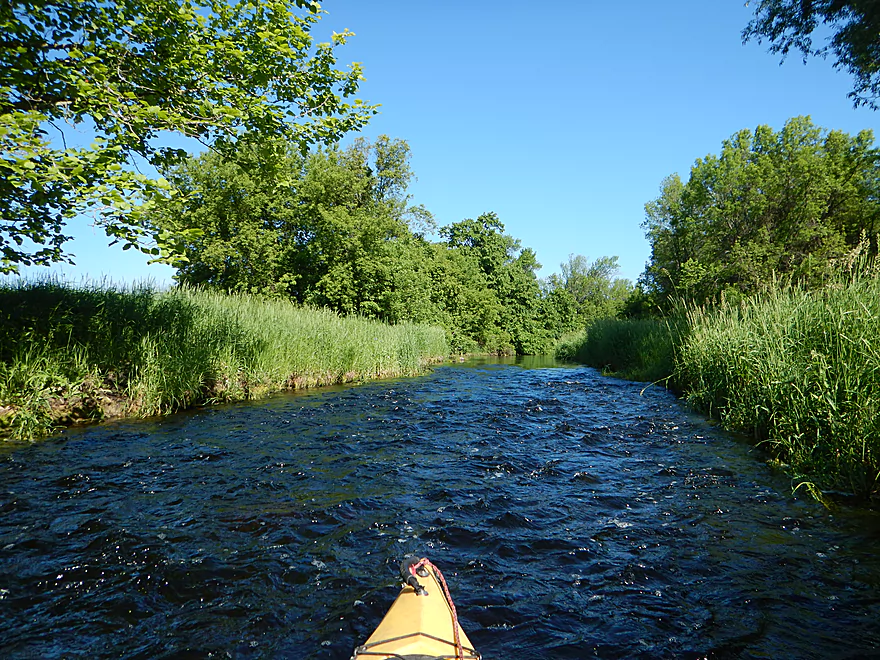








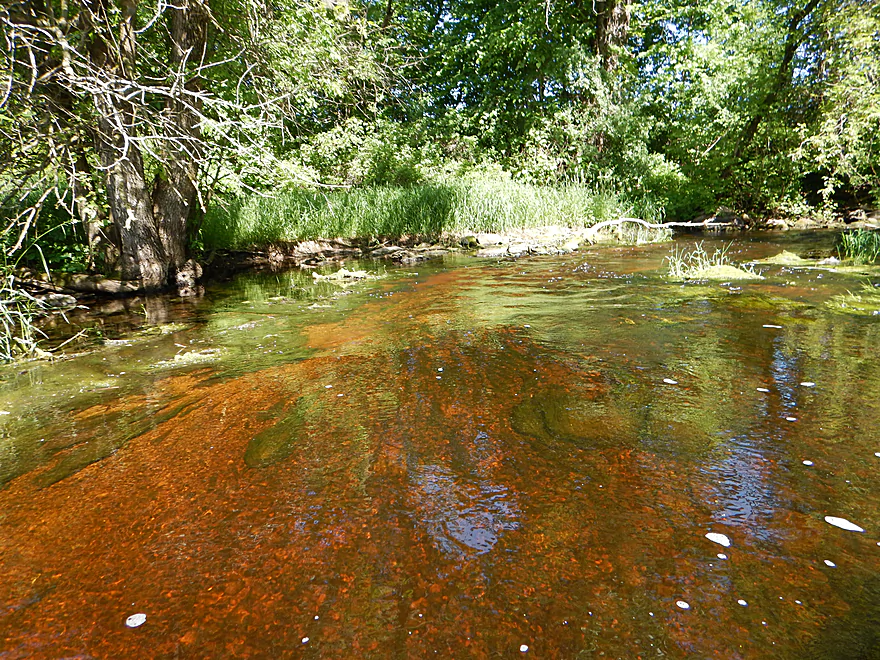
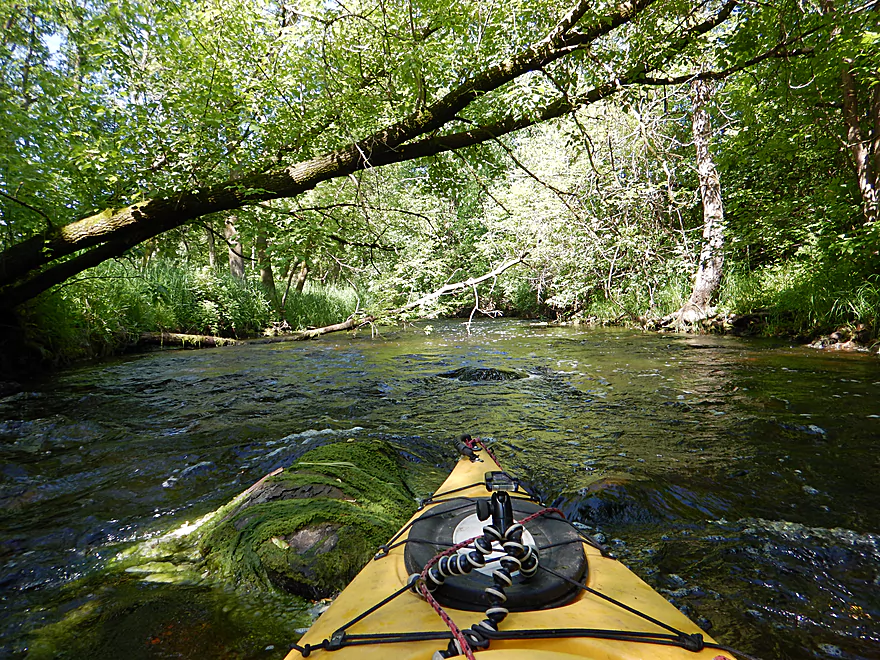


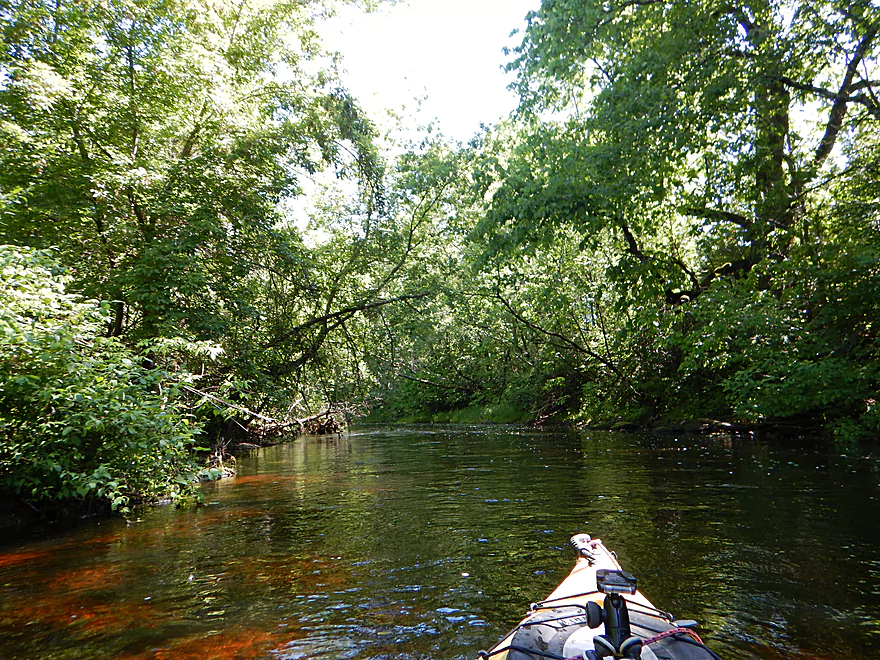
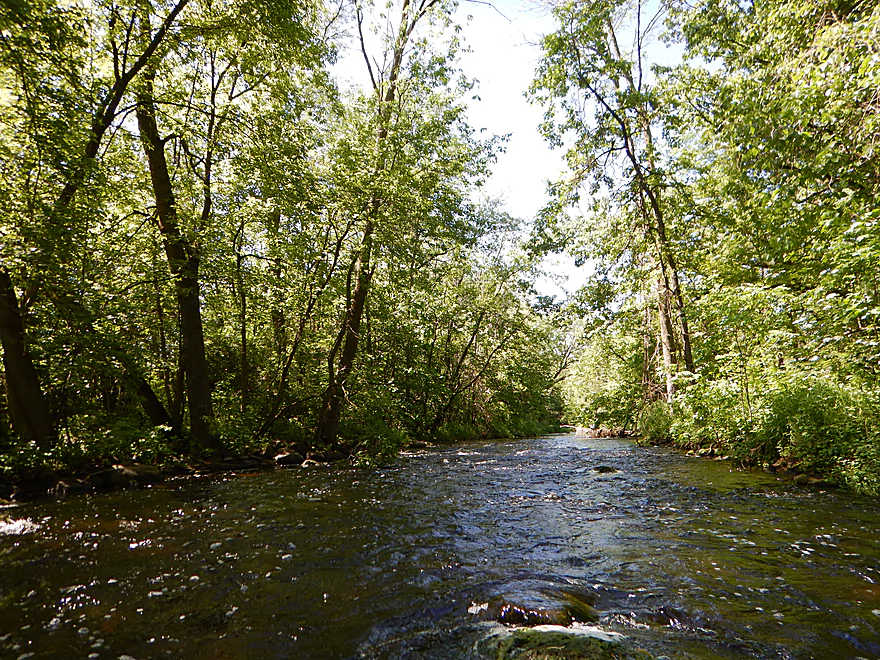

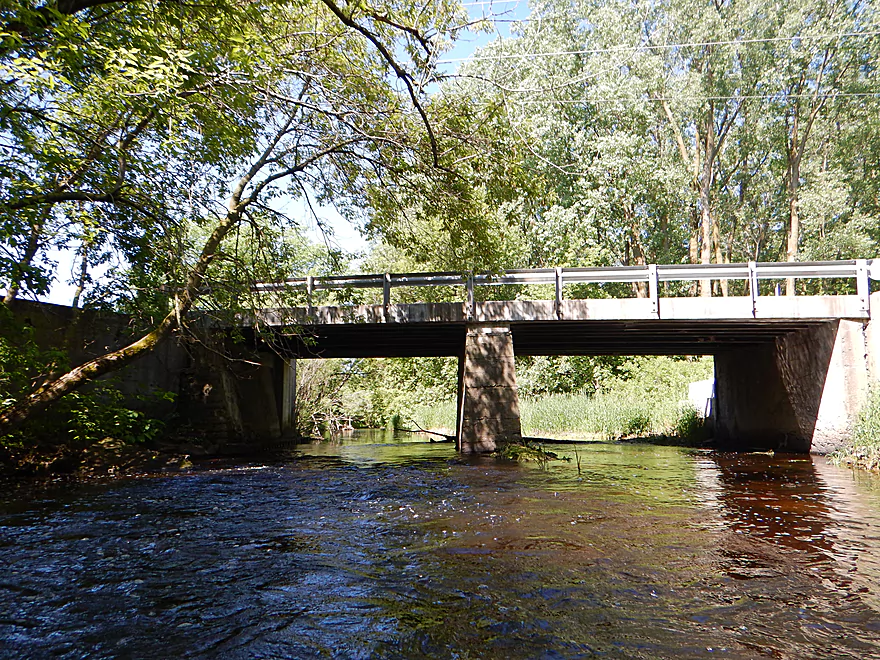




















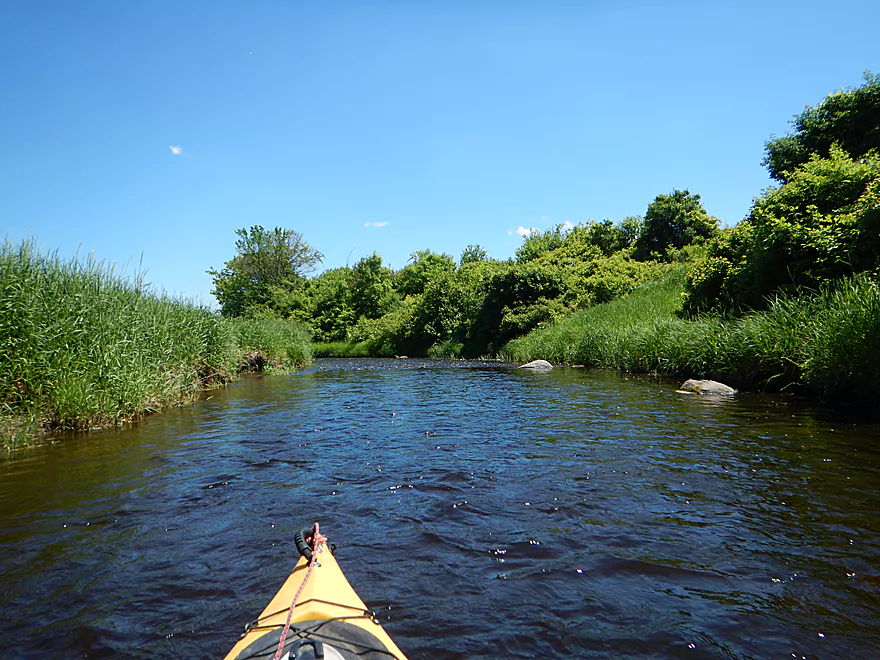



















We did this trip today and the water was super fast! We used our whitewater kayaks and it took us less than 2 hours to do. We were really nervous about running into strainers or log Jams, but the run was actually very clear beside a few branches hanging in your face. Thanks for the help on making our trip happen!
Thanks for the comment! You went when the river was VERY high (140 CFS). It is interesting and good to know that the river is still navigable at these levels and I appreciate the heads up.
I am 60 years old and would love to kayak the Fond du lac River but don’t want to go alone. Anyone interested?
Thanks Gary for the comment. Note if anybody is interested in doing a group paddle with Gary, you can contact me and I can relay his email address.
Another option Gary is to contact http://www.madcitypaddlers.org and they can likely arrange a group paddle on the river.
My boyfriend and I took this trip twice this weekend, once we started from townline road(decent put in) and the second Was just off Woodhull road(small walk, but easy enough). The first time we ended qt supples marsh took us 4 hours. No portages, but he did manage to tip twice. Second trip we ended at 41 because it was too dark to continue. We had inteded to end at hickory, but my incident took up quite a bit of time. Water was extremely fast, rapids were strong. We did get quite a bit of rain in the last few weeks. I did manage to get sucked under a log jam at one point and had to walk a few hundred yards to catch up to my kayak after pushing it down stream. But it was beautiful, until you got to the city, we had to portage three times. 2 were easy enough, the 3rd was after my incident and we just couldnt see far enough ahead. Turned out the river was split 3 ways and each had its own set of obstacles(trees, rocks, branches). Your video looks much more peaceful than our adventure.
It’s too bad to hear about your spill. In regards the differences in experiences, mostly this is attributable to water level. I went at 41 CFS which is an average depth, while you must have gone at 70-90 CFS which is much higher. Many rivers in the state that are fed by marshes (like Fond du Lac) are taking much longer to wind down from our big rainstorms.
Have you ever scouted the East Branch of the Fond du lac River. Looks like HWY D would be a good put in.
I did scout parts of it…and was worried about logjams. If you know more, definitely let me know.
We just ran this from 23 to Rogersville Rd on Wednesday 5-27-20 and it was extremely dangerous. It took us less than two hours. High water levels with a fast flow, two log jams we had to portage around which was difficult to get out with the current, and multiple spots where we had to squeak through spots. There was a strainer where it looked like maybe we’d fit but we didn’t dare chance it because if we didn’t fit we’d drown. We got caught up a couple times and I thought it was game over. The water is just too high for intermediate paddlers to do this safely at the moment. I hope this message gets to someone who can benefit from the knowledge. An organized cleanup to clear out the dangerous spots would be beneficial when the water level is lower. If it wasn’t for the spots I thought I was going to die it would have been an awesome trip. The rapids were thrilling but wait for the water levels to fall.
Thanks Marta for the warning. Yeah the gauge now is quite high and the river is likely too dangerous. This is one river best enjoyed at low levels.
Paddled on this beautiful day today (05/07/2023) at 73 CFS. The water level was honestly perfect at this flow rate. The current was zippy the entire way from 23 to Rogersville road. We were able to duck under 2 fallen trees that would be strainers at higher volumes, but the entire trip was clear without the need for a single portage!
My Strava App recorded only 5.98 miles on this journey (quite different than the 7.1 listed) and other than there being at least 2 dozen homes on the riverbanks of this journey (you must have been distracted from seeing them all) I too would give it a 5/5 ranking. It was indeed goldilocks perfect with an intimate, wooded feel, limited road noise, and enough current to be fast and interesting but not dangerous.
Appreciate the valuable updates! I agree the Fond du Lac is really underrated…not sure why it isn’t more popular.